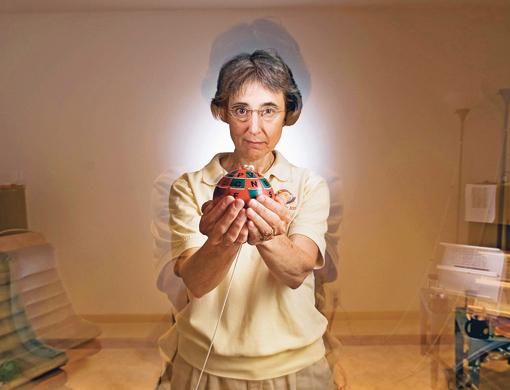A neurobiologist's work shows that adult brains can be retrained to correct vision problems.
In the early 1960s, when Susan Barry was in the 3rd grade, the assistant principal showed up one morning to demote her from the class for above-average students to the special-problems class. A boy was assigned to drag Barry's desk behind her down the hall, and the scraping sound it made on the floor would haunt her for years.
This was just one of many humiliations experienced by Barry, who since infancy had suffered with a vision problem that affects millions of children but is still profoundly misunderstood by science.
Barry developed a condition called strabismus, a misalignment of the eyes that causes a variety of conditions; in Barry's case, cross-eyes. Three surgeries as a child made her eyes appear straight, but they still were poorly aligned and sent such confusing signals to her brain that she experienced double vision and difficulty reading.
Barry compensated like those with similar vision problems. Her brain suppressed the image from one eye so she could learn to read. But she could barely see things at a distance. As a result, her brain could not compare the images from both eyes, which would create the perception of depth. Thus, she lacked the stereo vision of normal sight. To judge distances, Barry used other senses or cues, such as placing her hands in front of her or counting steps. Her world was jittery and flat.
Doctors told her this condition could never be changed because she had passed the crucial period of early childhood, after which the brain becomes fixed and cannot be rewired to read correct signals from the eyes.
But now, in a development that could affect such areas as learning disabilities and soldiers returning from war with traumatic brain injuries, Barry has proved that the adult brain is considerably more flexible than originally thought.
In Fixing My Gaze: A Scientist's Journey Into Seeing in Three Dimensions, Barry describes how, at 48, she began vision therapy that accomplished what scientists of her generation said could never be achieved - a brain that can read eye signals properly and allow sight in three dimensions.
"The majority of ophthalmologists still tell parents that there is nothing they can do for their child after the age of 7 or 8, because the brain is already fully formed," says Barry, now a professor of neurobiology at the Mount Holyoke College in South Hadley, Massachusetts. "Well, I was 48 when the right developmental optometrist taught me how to retrain my brain."
As a neurobiologist, Barry developed a lifelong interest in how people with vision problems and other disabilities compensate by strengthening their senses, and Fixing My Gaze is full of tales of marathon runners, ice skaters and dancers who developed remarkable careers by learning to "see" in other ways.
Barry's vision breakthrough began seven years ago. Annoyed that she was a neurobiologist and a vision specialist who nevertheless ignored the students in the back of her classroom because it was too hard to recognise their faces, Barry sought the help of a developmental optometrist who prescribed a rigorous programme of vision therapy. This therapy was designed to focus both eyes at once on the same object so the brain was receiving accurate, stereoscopic information.
One day, as she left the optometrist's office after her second year of therapy, Barry was starting her car when she glanced at the steering wheel and, suddenly, it was "floating in its own space, with a palpable volume of empty space between the wheel and the dashboard."
For the first time, Barry realised, she was seeing with normal, three-dimensional vision because her brain had been retrained.
With a few more years of intensive training - which she continues in a home-made laboratory in her basement - Barry was seeing normally, and a whole new world of distance vision, trees with normal dimensions and roads she could easily follow, opened up to her.
Discovering three-dimensional sight, and writing Fixing My Gaze, Barry says, has motivated her to become an advocate for people with vision problems.
About 4 per cent of The United States's population suffers from some form of strabismus. But when the population of children with learning disabilities, attention deficit hyperactivity disorder and other deficiencies is considered, perhaps 10 per cent of the school-age population could be helped by improved rehabilitation and understanding.
But vision conditions, Barry says, may be only the beginning of the problem.
"I want to explore the whole issue of rehabilitation strategies," Barry says. "If the adult brain is more adaptable than we thought, how can we use that discovery to help people with brain injuries and a host of other problems? We have to design better strategies for this population."



